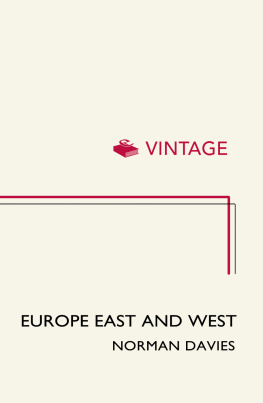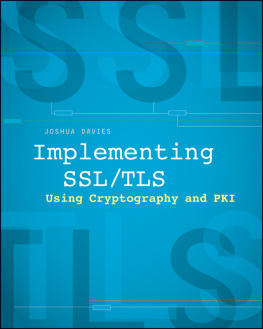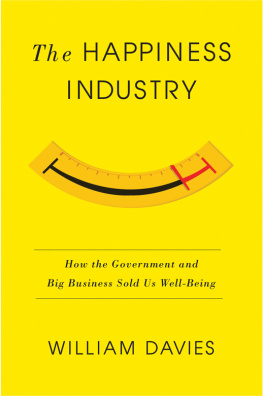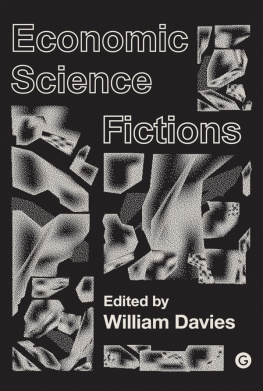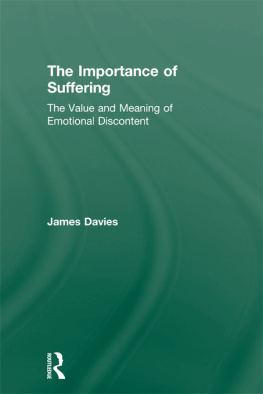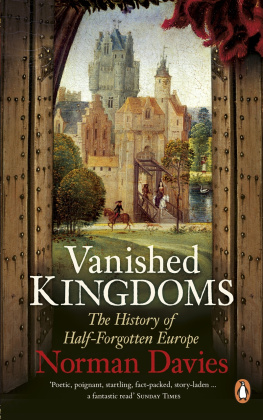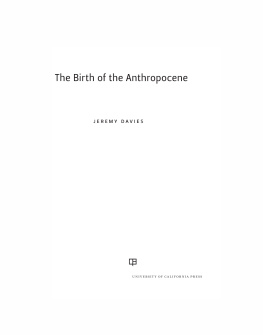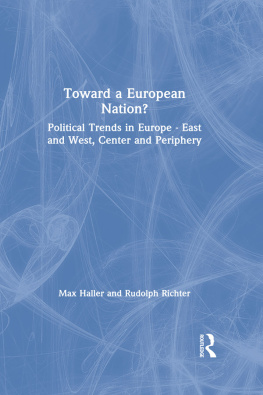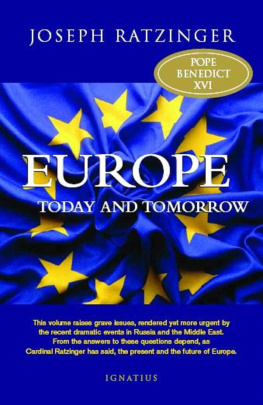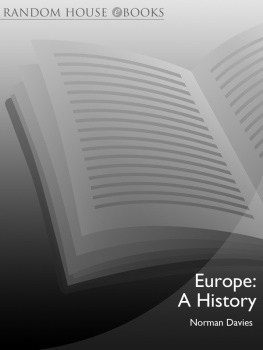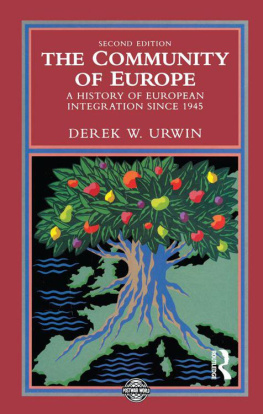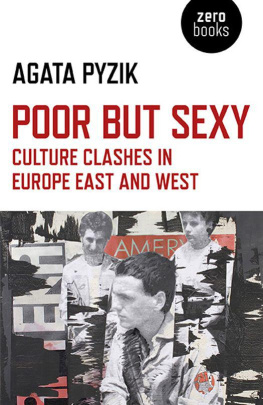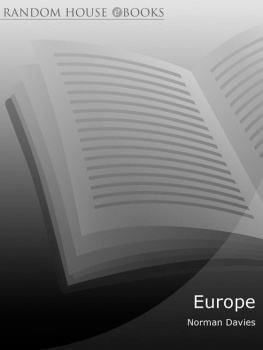CONTENTS
BY THE SAME AUTHOR
White Eagle, Red Star:
The PolishSoviet War, 191920
Heart of Europe:
The Past in Polands Present
Gods Playground:
A History of Poland
(2 vols)
Europe: A History
The Isles: A History
Microcosm:
Portrait of a Central European City
(with Roger Moorhouse)
Rising 44:
The Battle for Warsaw
ABOUT THE AUTHOR
Norman Davies C.M.G., F.B.A. is Professor Emeritus of the University of London, a Supernumerary Fellow of Wolfson College, Oxford, and the author of several books on Polish and European history, including Gods Playground, White Eagle, Red Star, Europe, The Isles and Rising 44.
ABOUT THE BOOK
Collected here for the first time are some of the numerous essays and lectures by Norman Davies, author of the bestselling and critically acclaimed Europe, The Isles and Rising 44. Spanning more than fifteen years of his remarkable career, this highly accessible collection addresses many of the issues that continue to dominate the political and cultural climate of Europe today.
From the classical origins of the idea of Europe to the division between East and West during the Cold War; from the Jewish and Islamic strands in European history to the expansion of Europe to other continents; from the misunderstood Allied victory in 1945 to Britain's place in Europe; from reflections on the use and abuse of history to personal recollections on learning languages - this companion volume to the bestselling Europe looks at European history from a variety of unusual and entertaining angles in an equally stimulating and accessible way.
EUROPE EAST AND WEST
Norman Davies
This ebook is copyright material and must not be copied, reproduced, transferred, distributed, leased, licensed or publicly performed or used in any way except as specifically permitted in writing by the publishers, as allowed under the terms and conditions under which it was purchased or as strictly permitted by applicable copyright law. Any unauthorised distribution or use of this text may be a direct infringement of the authors and publishers rights and those responsible may be liable in law accordingly.
Epub ISBN: 9781446467589
Version 1.0
Vintage Digital, an imprint of Vintage Publishing,
20 Vauxhall Bridge Road,
London SW1V 2SA
Vintage Digital is part of the Penguin Random House group of companies whose addresses can be found at global.penguinrandomhouse.com.
Copyright Norman Davies 2006
Norman Davies has asserted his right under the Copyright, Designs and Patents Act 1988 to be identified as the author of this work
First published in Great Britain in 2006 by Jonathan Cape
www.vintage-books.co.uk
A CIP catalogue record for this book is available from the British Library
ILLUSTRATIONS
The Rape of Europa by Peter Paul Rubens, copy after a painting by Titian (akg-images/Erich Lessing).
Europa and the bull, Apulian vase painting, fourth century bc (akg-images/ Erich Lessing).
Magdalen College, c. 1928 (Getty Images).
Edward Gibbon pictured in Switzerland, lithograph by C. Constans (Mary Evans Picture Library).
The Venerable Bede (Getty Images).
Pierre de Ronsard (Getty Images).
William Blake, engraving by W.C. Edwards (Getty Images).
Juliusz Sowacki, anonymous wood engraving (akg-images).
The Black Madonna of Czstochowa (The Granger Collection, New York).
The Crucifixion, sixteenth-century Greek icon painting (akg-images).
Johann Wolfgang von Goethe (Time Life Pictures/Getty Images).
Rudyard Kipling, c. 1930 (The Granger Collection, New York).
The School of Athens by Raphael, 150811, detail showing central group with Plato and Aristotle (akg-images/Erich Lessing).
Llanfairpwllgwynggylgogerychwyrndrobwllllantysiliogogogoch, the Welsh railway station with the worlds longest place name, 1935 (Getty Images).
Hell, Purgatory and Paradise by Domenico Michelino, 1465 (Time Life Pictures/Getty Images).
Vladimir Mayakovsky, c. 1925 (akg-images).
Botany Bay, eastern Australia, c. 1800 (Getty Images).
Fort Ross, Bodega Bay, California, 1828 (Getty Images).
King Wadysaw Jagiellon at the battle of Grunwald, painting by J. Matejko
(Time Life Pictures/Getty Images).
Reception of August the Strong in the Berlin Palace (by Frederick William I and Sophie Dorothea), painting by Antoine Pesne, 1728 (akg-images).
In a Polish Jewish Town, postcard from a series photographed during the German occupation of Poland in the First World War, c. 191516 (akg-images).
Arthur James Balfour visits a Jewish settlement in the British Mandate of Palestine, 1925 (akg-images).
Abu Abdullah (Boabdil), known as The Unfortunate, the last Moorish emir of Granada (Time Life Pictures/Getty Images).
Europe Is Liberated from the Turks, Austrian educational picture from 1959 depicting the battle of Kahlenberg, 12 September 1683 (akg-images).
The Zaporozhye Cossacks Writing a Mocking Letter to the Turkish Sultan Mehmet IV by Ilya Repin, 188091 (akg-images).
RAF Westland Wapitis on a reconnaissance flight over the mountains of Kurdistan, Iraq, March 1934 (Getty Images).
Leopold von Ranke, c. 1880 (Getty Images).
Nikolai Mikhailovich Karamzin.
Heinrich Himmler (Time Life Pictures/Getty Images).
Lavrenti Pavlovich Beria, c. 1946 (Getty Images).
The snow-covered belongings of those deported to Auschwitz-Birkenau litter the railway tracks leading to the camps entrance, c. 1945 (Getty Images).
Vorkuta, 1930s/1940s (Nowosti/ullstein bild ).
Winston Churchill addressing the Congress of Europe, The Hague, 29 May 1948 (Getty Images).
Boris Yeltsin addresses the people outside the White House, 19 August 1991 (Nowosti/ullstein bild ).
Robert Schuman (Time Life Pictures/Getty Images).
Pope John Paul II at the Immaculate Conception School, Los Angeles, 1987 (Time Life Pictures/Getty Images).
The cover of the Japanese edition of Europe: A History.
The Italian jacket for Rising 44.
Master and pupil: A.J.P. Taylor and Norman Davies.
Norman Davies receives his honorary DLitt from the University of Sussex, 2006.
INTRODUCTION
T HIRTY years ago, when I wrote my first book, the Cold War was at its height. We lived under the threat of nuclear exchange between the West and the Soviet East. Britain had just joined a European Economic Community that did not reach beyond West Germany. The Iron Curtain ran in an unbroken line from Lbeck to Trieste. The countries to the east of the Curtain were ruled by grim, communist regimes controlled by Moscow. What is more, the Iron Curtain was making inroads into our minds. The name Europe no longer seemed to apply to the whole of the continent, but was increasingly used as a shorthand term for the European project in our western half. The deadlock looked insoluble. The USSR possessed the largest nuclear arsenal in the world and looked invincible. The idea of a free and united Europe had become a mirage.

